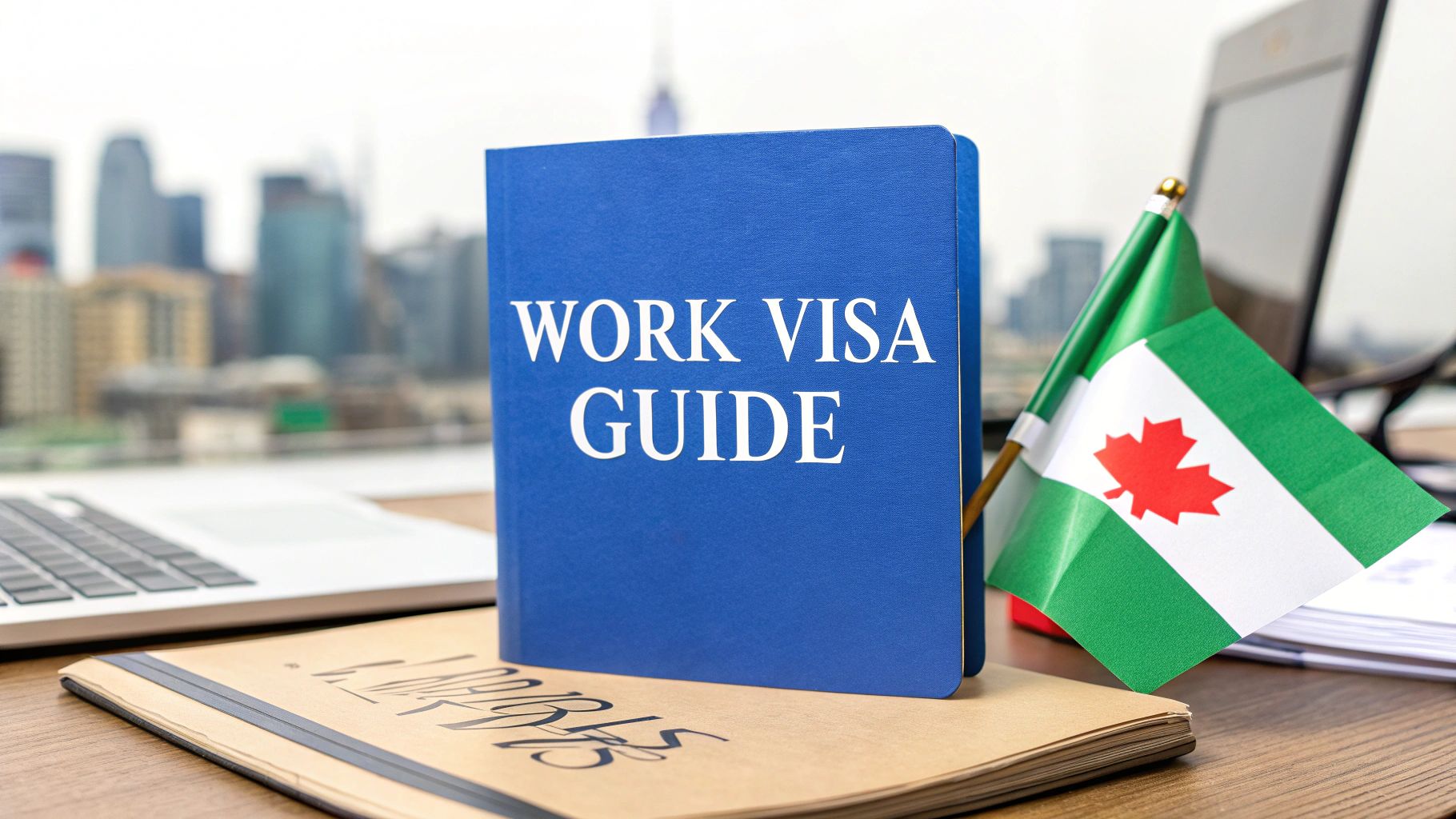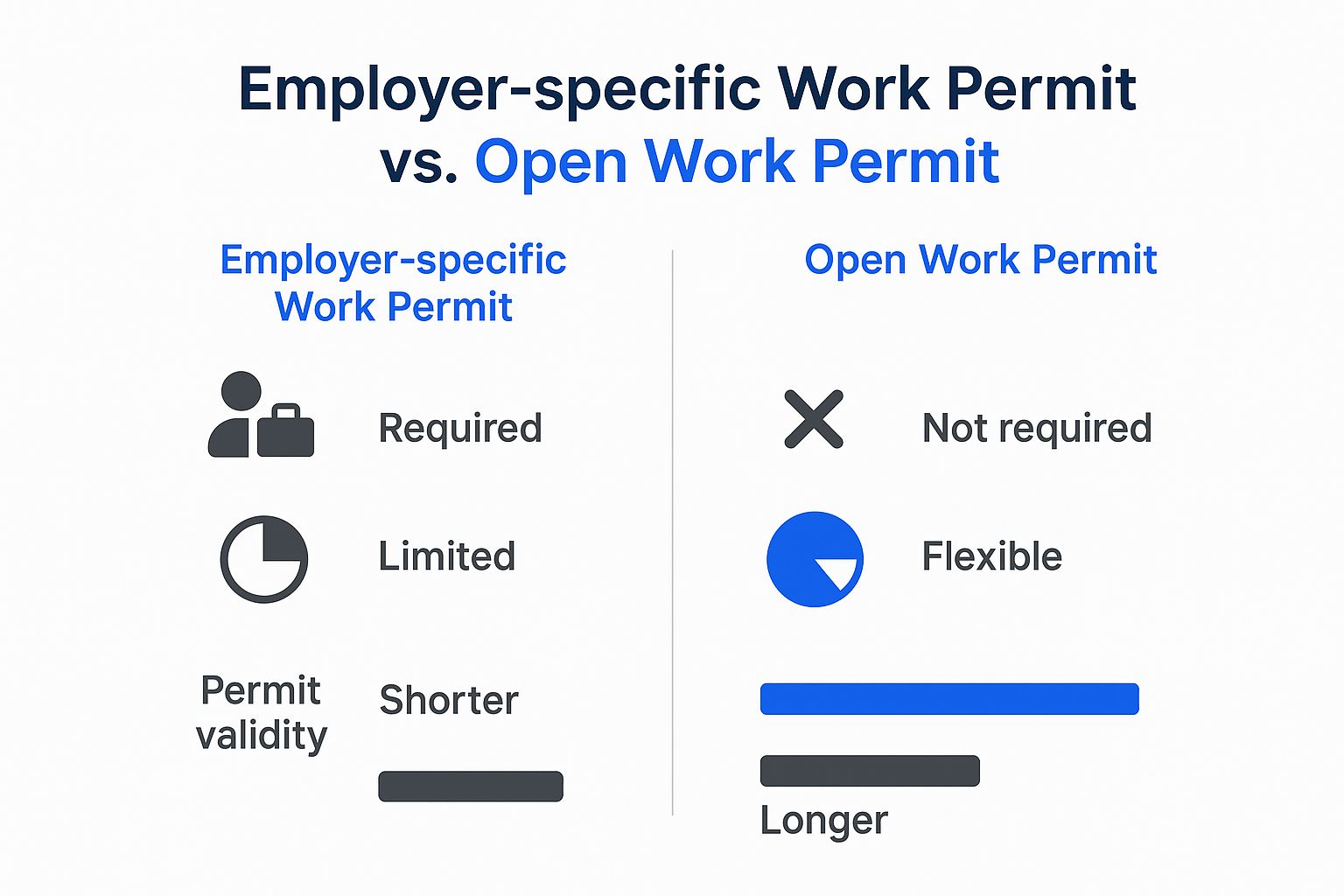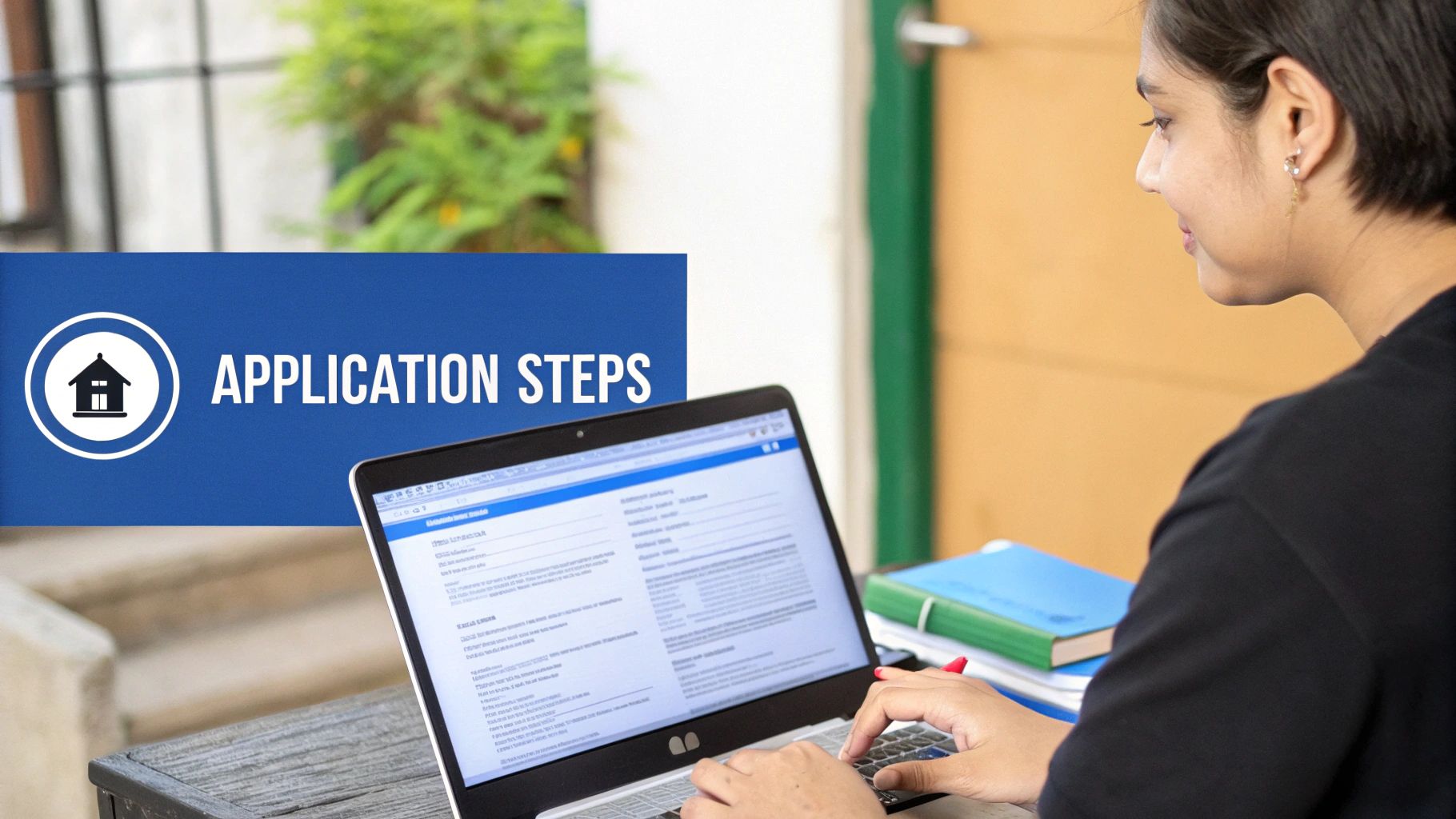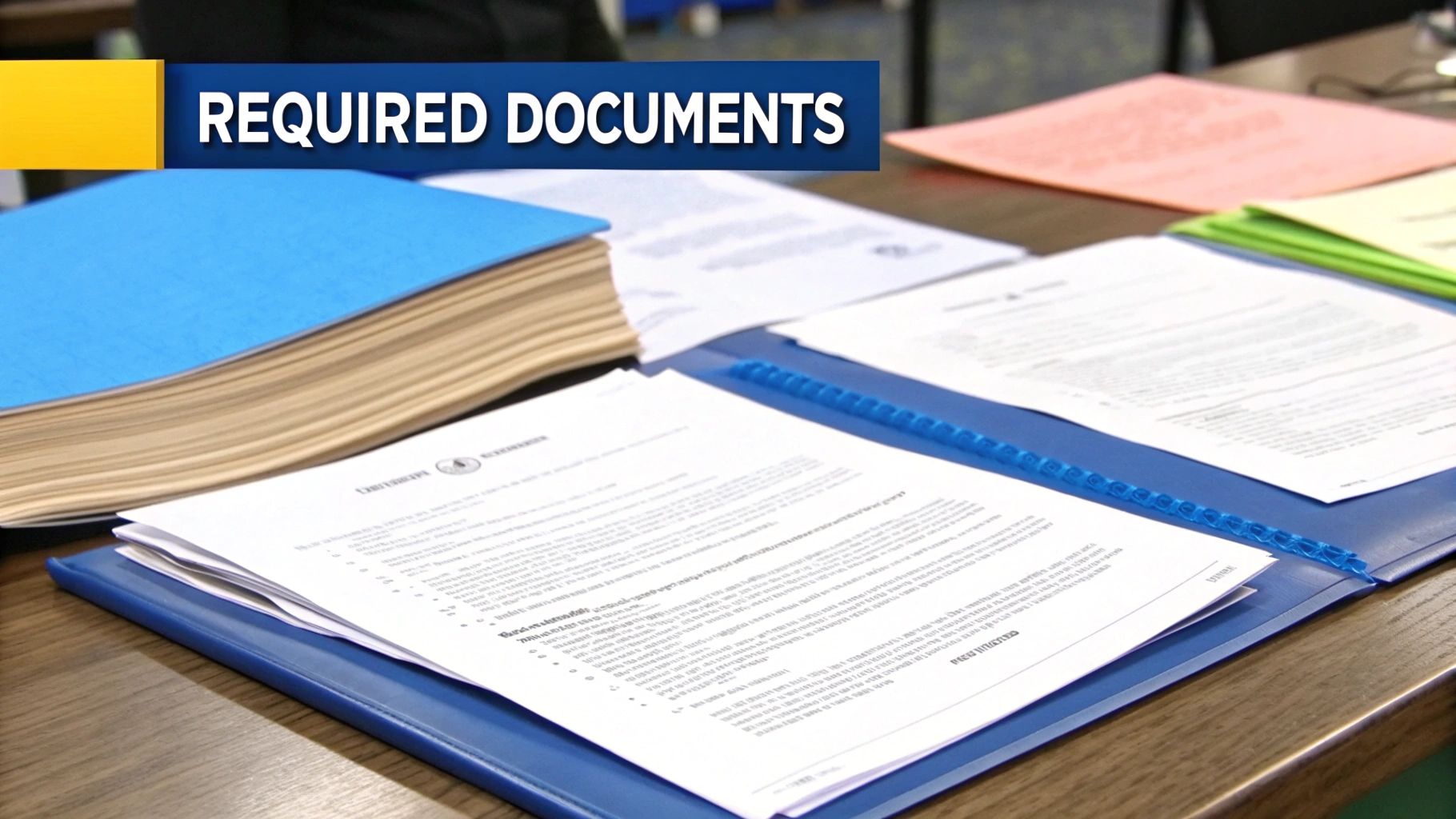How to Obtain a Canadian Work Visa From Nigeria

So, you're looking to get a Canadian work visa from Nigeria. The absolute first thing you need to know is that it all starts with a valid job offer from a Canadian employer. This isn't just a suggestion; it's the key that unlocks the whole process. Canada's system is built to bring in people who can fill specific gaps in their job market.
Understanding Your Path to Working in Canada
Many Nigerians think the first step is to find a visa application form, but that's not quite right. The journey almost always begins with landing a job. It's less like applying for a tourist visa and more like getting sponsored by a company that truly needs your skills. This way, Canada ensures that people coming to work are filling real, existing needs in the workforce.
The Canadian government has two main programmes for this. Getting a handle on them will make your job search much more focused and effective.
TFWP vs IMP: Which Program Fits Your Job Offer?
So, how do you figure out which path you're on? It all comes down to the type of job offer you get. The two big programmes are the Temporary Foreign Worker Program (TFWP) and the International Mobility Program (IMP). They sound similar, but they work quite differently.
Here's a quick breakdown to help you see where you might fit.
| Feature | Temporary Foreign Worker Program (TFWP) | International Mobility Program (IMP) |
|---|---|---|
| Main Purpose | To fill labour shortages when no Canadian is available. | To advance Canada's economic, cultural, or social interests. |
| Key Requirement | Requires a Labour Market Impact Assessment (LMIA). | LMIA-exempt. The employer submits the offer directly. |
| Who is it for? | Often for roles where there's a proven shortage (e.g., specific trades, healthcare). | For roles in high-demand tech fields, intra-company transfers, or under international agreements. |
| Example for a Nigerian | A civil engineer from Port Harcourt gets a job after the employer proves no Canadian could fill the role. | A UX designer from Lagos is hired through the Global Talent Stream, a fast-track IMP route. |
Essentially, your job offer will dictate whether your employer needs an LMIA (putting you in the TFWP) or if you qualify for an LMIA exemption (placing you in the IMP).
The Two Main Work Permit Streams
Once you have that job offer, you'll be applying for one of two main types of work permits. The one you get depends entirely on your job offer and the programme you fall under.
-
The Temporary Foreign Worker Program (TFWP): This is the route for when a Canadian company has tried and failed to find a Canadian citizen or permanent resident for a job. They have to get a document called a Labour Market Impact Assessment (LMIA) to prove it.
-
The International Mobility Program (IMP): This programme is for jobs that are considered to offer a big economic, cultural, or competitive advantage to Canada. Because of this, these jobs are exempt from the LMIA process, making it a faster route.
The infographic below really helps visualise the difference between the two main outcomes: an employer-specific permit (the most common) and an open work permit.

As you can see, the type of permit you receive directly impacts your flexibility to work for different companies or in different parts of Canada. Most initial work permits tied to a TFWP or IMP job offer are employer-specific.
There's a noticeable trend towards the International Mobility Program right now, especially as many Nigerian international students transition to work after finishing their studies in Canada. While approximately 40% of new permanent residents first came to Canada on temporary permits (like work or study), it's also worth noting that recent policy changes have tightened the rules for spousal open work permits, which could impact some Nigerian families' plans.
The most important thing to remember is this: Your job offer dictates your visa path. Instead of spending hours searching for "Canadian visa application," your first goal should be finding Canadian employers in your field who are willing to hire international talent.
As you start planning your big move, it's also a fantastic idea to get to know the country better. To get a real feel for the vast and beautiful landscape you hope to call home, you could even explore some Canadian train tours to see its natural wonders up close.
Getting a Real Canadian Job Offer
Let's be blunt: your Canadian job offer is the absolute cornerstone of your work visa application. Everything else hinges on it. Without a genuine, valid offer from a Canadian employer, you're not going anywhere. This is where your hard work and smart strategy truly begin.
Your search will likely start online, but you have to be clever about it. Forget generic job boards and focus on the heavy hitters: the official Government of Canada Job Bank and LinkedIn are your best bets. These are the platforms where serious Canadian companies hunt for talent.
Imagine you're an IT project manager in Lagos aiming for a tech role in Vancouver. You wouldn't just fire off a generic CV into the void. The smart move is to connect directly with hiring managers and recruiters on LinkedIn, join Canadian tech industry groups, and tweak your profile to shout "I have the skills you need in Canada!"

Ditch the Nigerian CV—Think Canadian
One of the most common mistakes I see is professionals from Nigeria using a CV format that just doesn't fly in Canada. Canadian employers have specific expectations, and your job is to make it incredibly easy for them to see why you're the right fit.
Here's how to whip your CV into Canadian shape:
- Be brief and to the point. Keep it to two pages, maximum. Immediately cut personal details like your date of birth, marital status, or state of origin. They don't belong on a Canadian CV.
- Show your impact, don't just list tasks. Instead of a boring line like, "Was in charge of social media," quantify your success. Try this: "Grew social media engagement by 45% in six months by launching a new data-driven content strategy." Numbers speak volumes.
- Use their language. Simple swaps make a big difference. For example, say "post-secondary education" instead of "tertiary education." It’s a small detail that shows you've done your homework.
Making these changes transforms your CV from a simple historical record into a powerful marketing tool that sells your expertise.
Crucial Tip: Let me be crystal clear. If any "agent" or company asks you to pay them for a job offer, run. A legitimate Canadian employer will never ask you for money to cover a job or a Labour Market Impact Assessment (LMIA). That's a classic scam.
What to Look for in a Valid Job Offer
When that exciting email with an offer lands in your inbox, your work isn't over. You need to scrutinise it to ensure it meets the strict requirements of Immigration, Refugees and Citizenship Canada (IRCC). A proper job offer is a formal document, not just a quick note.
A valid offer letter must be on official company letterhead and clearly state:
- Your full name and the employer’s full contact details.
- Your official job title and a detailed breakdown of your duties.
- The salary or wage, along with any benefits or other compensation.
- The physical address where you'll be working.
- Your employment start date and the contract duration.
As you explore your options, don't limit yourself. There are potential career opportunities in property management, for instance, which is a booming sector in many Canadian cities.
Getting these details right is non-negotiable. To better understand how the job offer fits into the bigger picture, check out our detailed guide on the https://blog.japachat.com/canada-work-visa-permit/. Making sure your offer ticks all these boxes is key to ensuring it strengthens, rather than sinks, your work visa application.
Getting Your Documents in Order: A Nigerian Checklist
Alright, you’ve landed the job offer – congratulations! Now comes the part that can feel a bit daunting: gathering all the paperwork. Think of this as building your case for the Canadian immigration officer. It’s less about just collecting documents and more about telling a clear, organised story of who you are and why you're a great candidate.
For us in Nigeria, there are a few specific hurdles to be aware of. Getting this part right from the start can save you a world of headaches and delays down the line.
The Absolute Must-Haves: Your Personal Documents
Let's begin with the basics. These are the non-negotiable items that form the foundation of your application. Don't slip up here.
-
International Passport: This is your golden ticket. Check the expiry date right now. Is it valid for the entire time you plan to be in Canada, and then some? If it's cutting it close, I strongly recommend renewing it before you even think about applying. A last-minute renewal is a stress you don't need.
-
Recent Photographs: Canada is famously strict about its visa photos. You can't just use any old passport picture you have lying around. The dimensions are precise: 35 mm x 45 mm. My advice? Find a photography studio in Lagos or Abuja that specifically mentions they do Canadian visa photos. They'll know the rules about the white background, neutral expression, and correct sizing.
Showcasing Your Skills: Professional and Educational Proof
This is where you directly link your experience in Nigeria to the job waiting for you in Canada. You need to prove you're the right person for the role.
First up, you'll need reference letters from your past employers. Now, the kind of brief, "he worked here from X to Y" letter we're used to in Nigeria simply won't cut it. A Canadian-style reference letter needs to be on official company letterhead and must detail your job title, key responsibilities, salary, and your start and end dates. Be proactive – ask your old manager to be specific about your duties and accomplishments.
Then, there's your education. Depending on the job, you might be asked for an Educational Credential Assessment (ECA). This is basically a report from a designated body like World Education Services (WES) that confirms your Nigerian degree is equivalent to a Canadian one. The ECA process isn't quick, so if it's a requirement for your role, get on it immediately.
Your paperwork needs to paint a picture. A detailed reference letter from a tech firm in Yaba that lists the specific software projects you led is infinitely more convincing than a simple degree certificate. It gives them tangible proof of your abilities.
Nigerian-Specific Hurdles to Clear
Now, let's talk about the documents that require you to navigate some local systems here in Nigeria. These are often where people get stuck, so pay close attention.
Police Clearance Certificate (PCC)
This is essential. Canada needs to see you don't have a criminal record. To get this, you have to go through the Nigeria Police Force Criminal Investigation Department (CID). This isn't an overnight process; it can take several weeks. Make applying for your PCC one of the very first things you do. Don't leave it for the last minute.
Proof of Funds
You have to prove you can support yourself when you first arrive. This means providing six months of bank statements from your Nigerian bank. The statements must clearly show your name, the bank's address and contact info, and a steady history of your finances. A huge, unexplained lump sum appearing in your account right before you apply is a major red flag for visa officers. They want to see stability.
Medical Examination
Finally, the medicals. This isn't something your family doctor can handle. You must book an examination with an approved panel physician designated by Immigration, Refugees and Citizenship Canada (IRCC). In Nigeria, you'll find these doctors in Lagos and Abuja, with appointments often managed through the International Organization for Migration (IOM). You need to book this well in advance, and they send the results directly to IRCC on your behalf.
Getting to Grips with the Online IRCC Portal
Once you've got all your documents sorted, it's time to tackle the main event: the Immigration, Refugees and Citizenship Canada (IRCC) secure online portal. This is where you'll pull everything together. It might seem a bit daunting at first, but it's a straightforward system once you get the hang of it. The key here is to be meticulous and completely honest.
First things first, you'll need to create your secure IRCC account. Think of this as your personal command centre for the entire application journey. From the moment you submit to the final decision, this is where you'll get all your updates from the Canadian government. It's crucial to use a professional email address that you check religiously, as this is where all official correspondence will land.
Here’s a look at the sign-in page. This is your gateway—either to log in if you already have an account or to register for a new one.

This portal is your direct link to IRCC. Treat your login details and security question answers like gold – you'll need them.
Filling Out the IMM 1295 Form
Once you're logged in, the heart of the application is the IMM 1295 form, officially titled the "Application for Work Permit Made Outside of Canada." This is a detailed digital form where you'll enter everything from your personal details to your family background and complete work history.
Go through it slowly. Double-check every single field before moving on. A simple typo in your name or passport number can throw a wrench in the works and cause frustrating delays.
Be absolutely transparent, especially when it comes to your work history. The details you enter must perfectly mirror what's in the reference letters you’re submitting. Even a small inconsistency could be flagged as misrepresentation, which is a serious issue. It can lead to severe consequences, including a potential five-year ban on applying to enter Canada. It’s just not worth cutting corners.
For a more detailed walkthrough of each stage, you can find a lot more information on how to apply for a work visa in our complete guide.
My Personal Tip: Download a PDF version of the IMM 1295 form before you start the online application. Fill it out on your computer offline. Then, step away for a day and come back to review it with a fresh pair of eyes. Only after you've done this should you start transferring the information to the official online portal. You'd be amazed at how many little mistakes this simple habit can catch.
Handling Fees and Booking Your Biometrics
After you’ve filled out all the forms and uploaded your documents, the portal will guide you to the payment section. You'll typically have to pay the work permit processing fee and the biometrics fee. The payment is done online with a credit or debit card (like a Visa or MasterCard) that’s enabled for international transactions.
As soon as your payment goes through, you will receive a Biometric Instruction Letter (BIL) in your IRCC account. This isn't an optional step; it is 100% mandatory. You must book an appointment at a Visa Application Centre (VAC) in Nigeria—they have offices in Lagos and Abuja—to get your fingerprints scanned and your photograph taken.
The biometrics process follows a clear sequence:
- Submit Your Application: First, complete and submit the entire online application.
- Pay the Fees: Next, pay both the application processing fee and the biometrics fee.
- Get Your BIL: You'll have to wait for the official Biometric Instruction Letter to pop up in your IRCC account.
- Book Your Slot: Use the information in your BIL to book an appointment at the nearest VAC.
- Attend the Appointment: On the day, head to the VAC with your international passport and a printed copy of the BIL.
Your application is not officially in the processing queue until after you’ve submitted your biometrics. Procrastinating on booking this appointment can needlessly stall your application, so get it done as soon as that BIL arrives.
Canada’s Immigration Goals and What They Mean for You

To really get ahead in the Canadian visa game, you need to understand the bigger picture. It’s not just about ticking boxes on a form; it's about seeing what Canada is looking for and showing them you’re the perfect fit. This insight gives you a massive strategic advantage.
Think of it this way: if you knew a company was desperately seeking IT staff, you’d make sure your tech skills were front and centre on your CV. It’s the same with Canada. Knowing their economic priorities helps you highlight the right parts of your professional background, whether you're a nurse from Abuja or a software developer from Lagos.
What the Numbers Tell Us
The Canadian government is refreshingly transparent about its immigration targets. They publish an official Immigration Levels Plan that lays it all out. For the 2025-2027 period, for instance, the goals are ambitious. They're looking to welcome 395,000 new permanent residents in 2025 alone.
What’s really important for you is that a huge slice of that pie—over 232,000 spots—is reserved for economic programmes. These are the streams designed for skilled workers just like you. You can dig into the official numbers yourself by checking the Canada Immigration Levels Plans details.
This isn't just good news; it's a clear signal that the door is wide open for skilled professionals. But there’s a catch. The plan also shows Canada is becoming more selective. They're aiming to reduce the number of temporary residents to 5% of the total population by 2027. This means that while the opportunities are there, they're becoming more focused. Canada is looking for people who can fill specific labour shortages and contribute to the economy for the long haul.
Your work visa isn’t just a temporary pass. For many Nigerians, it’s the very first step on the journey to a new life. Starting with a work permit and then transitioning to permanent residency is a well-trodden path. If you align your application with Canada's needs from day one, that future transition becomes so much smoother.
A Path to Permanent Residence
This strategic approach is fantastic news for anyone with in-demand skills. Canada isn’t just looking for a temporary fix for its labour market; it’s actively searching for future Canadians. Your work permit can be a direct bridge to permanent residency through programmes like the Canadian Experience Class.
Once you prove your value to a Canadian employer and become part of the local workforce, you build a powerful case for staying permanently. Understanding this from the start helps you see the long-term potential. A great way to get a head start is to familiarise yourself with the process of creating an Express Entry profile, which is the main system for permanent residency applications. Your Canadian work experience will be a huge asset in that system.
Your Top Canadian Work Visa Questions, Answered
Going after a Canadian work visa from Nigeria naturally brings up a lot of questions. Let's walk through some of the most common concerns I hear from applicants, providing straight answers to help you move forward.
How Long Will This Whole Process Take?
This is probably the number one question on everyone's mind. The honest answer? It varies. A lot. The time it takes depends heavily on where you're applying from (Nigeria), the specific type of work permit, and how busy Immigration, Refugees and Citizenship Canada (IRCC) is at that moment.
For some high-demand roles, like those under the Global Talent Stream, you might see a decision in a few weeks. For most others, it's more realistic to expect a wait of several months. The key is to check the official IRCC processing times tool regularly for the latest estimates. And remember, the clock only starts ticking after you’ve given your biometrics.
Can I Bring My Family With Me to Canada?
Absolutely, this is often possible. If you’ve landed a work permit for a skilled position (usually in TEER categories 0, 1, 2, or 3), your spouse or common-law partner can often apply for an open work permit. This is a huge advantage, as it allows them to work for almost any employer in Canada without needing their own job offer first.
Your dependent children can also come along and are usually eligible to enrol in Canadian schools. Just make sure you include everyone on your initial application to avoid major headaches and delays down the line.
A Word of Advice: You must convince the visa officer that you'll return to Nigeria when your work contract ends. This is called "dual intent." Even if you secretly hope to become a permanent resident one day, you still need to show strong ties to home—things like family, property, or a business you own in Nigeria. This is non-negotiable.
What Happens if My Visa Application is Refused?
Getting a refusal is tough, but don't let it be the end of your dream. The first thing you must do is read the refusal letter from IRCC very carefully. It will spell out exactly why they made that decision. Common reasons include doubts about your finances, questions about the legitimacy of the job offer, or a belief that you won't leave Canada when your permit expires.
Once you understand the problem, you can often fix it and reapply. For example, if they weren't convinced by your proof of funds, you can gather stronger financial documents for your next submission.
It’s good to keep an eye on the bigger picture. The Canadian immigration scene is always changing. While there was a slight dip in new immigrants in the first quarter of 2025, the number of temporary residents is still massive. As of April 2025, there were over 1.45 million people in Canada on a work permit alone. This shows the demand for foreign talent remains incredibly high. You can read more about these demographic trends to understand the landscape.
Feeling a bit lost in all the details? JapaChat is here to guide you. As Nigeria's first AI immigration expert, we give you instant, accurate answers to your questions, helping you plan your move with real confidence. Get started for free and join over 10,000 Nigerians who are making their Canadian dream a reality.

Leave a Reply